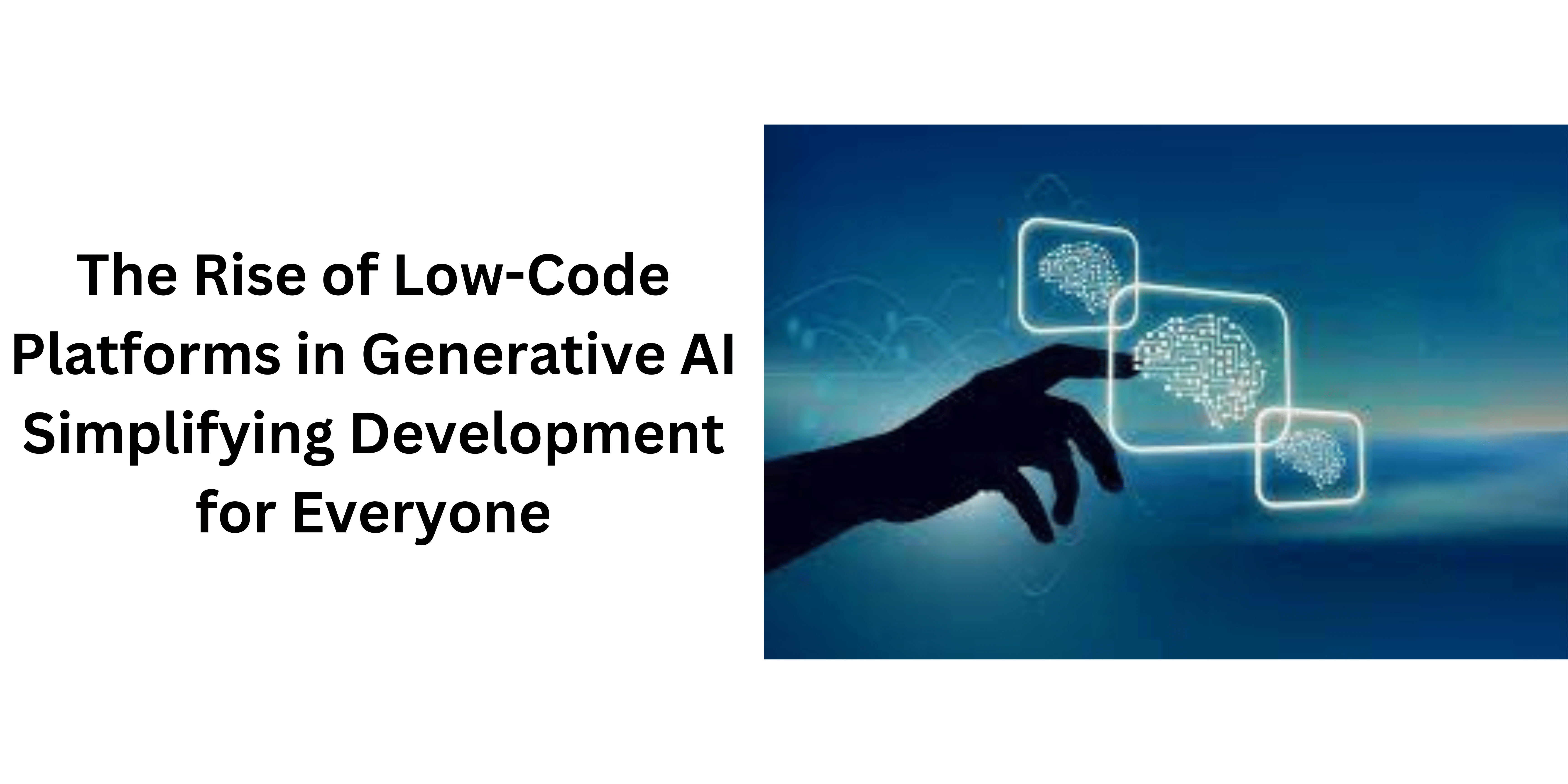In the last few years the convergence of AI and development of software has been an enlightening phenomenon characterized by the rise of low-code systems within the realm of generative AI. The paradigm shift captured in the topic of “The Rise of Low-Code Platforms in Generative AI Simplifying Development for Everyone,” reflects an increasing trend toward open access to AI capabilities.
With the development of artificial intelligence (AI), including generative AI, there is a growing demand for a more efficient process of development, leading to the rise of low-code solutions as effective enablers for both developers and non-developers. This article sets the stage to look at the vital function of low-code solutions in simplifying the previously complex world of AI development, encouraging inclusion, and speeding up technological advancement. Entities such as a generative AI development company play a significant role in this evolving landscape.
When we examine the multiple aspects of this revolutionary trend, it becomes clear that low-code platforms aren’t only tools, they are a paradigm shift to make AI development easier and more efficient to a wider range of people and industries.
Emergence of Generative AI
The advent of the concept of generative AI represents a major milestone in the advancement of artificial intelligence, bringing an age of innovation that is characterized by machines’ capacity to produce content, develop innovative ideas, and imitate humans’ creative abilities. Contrary to the traditional AI models that are based on patterns and rules that are predefined, the generative AI surpasses mere pattern recognition, and exhibits an ability to create original and relevant outputs.
The fundamental principle of the concept of generative AI is its dependence upon neural networks in particular versions such as Generative Adversarial Networks (GANs) and Recurrent Neural Networks (RNNs). GANs, for example, comprise two neural networks: one generator and the other a discriminator that are in a continuous feedback loop. Generators create data, and the discriminator analyzes the data, which results in an iterative process of refinement. This process allows the system to improve and create more authentic content, be it as text, images and even songs.
Generative AI has applications in a variety of areas, including content creation and artistic endeavours to problem-solving in practical ways. In the realm of creative it helps artists by creating visual concepts that aid creating original art works. In the field of text generation, models such as OpenAI’s GPT-3 demonstrate the capacity to create consistent and contextually relevant textual content. It also makes progress in natural language comprehension.
However, the advent of the emergence of generative AI can also bring ethical concerns like the potential for deepfake technologies to produce convincing but fake content. Finding an equilibrium between responsible and innovative deployment is essential as the field of generative AI is constantly evolving in a way that is shaping industries and challenging traditional concepts of creativity and problem-solving. As the technology develops and becomes more widely used, its impact on different industries will be dramatic and will alter how we view the world around us, interact with and use AI in our everyday lives.
The Need for Simplified Development
The speed of technological development, particularly in the field of AI (AI) has highlighted the need for a streamlined process of development. As AI applications become more and more essential to various industries, the demand for easy and user-friendly development tools has never been more evident. This demand isn’t only caused by the complex nature of AI algorithms, but also the increasing need for a larger population of people, beyond skilled programmers, to take part in and benefit from the advancements made by AI.
Traditional AI development usually involves a lot of programming, complicated algorithms, and a thorough understanding of machine learning concepts which creates a barrier to access that restricts participation to a small subset of experts. The need to simplify development stems from the desire to make access more accessible to AI and make it accessible and accessible to a wider population. Innovative companies and developers realize that the decentralization of AI is the most effective way to unleash its potential across a variety of industries.
Tools for development that are simplified such as low-code platforms, enable people with different technical backgrounds to take part with AI development without the need for an extensive knowledge of programming. By abstracting complicated programming tasks, these tools enable users to concentrate on the development and application of AI solutions, rather than being overwhelmed by intricate programming specifics. This move towards simplicity does not just speed up the process of development but also promotes an environment of innovation in which people from different fields can bring their unique viewpoints in AI projects.
Additionally, streamlined development can address the ever-growing gap in skill levels in AI by allowing professionals who have expertise in their field, but lack programming experience, to be actively involved in the development and deployment of AI applications. The necessity for streamlined development can be an opportunity to democratize AI to ensure that its potential for transformation is tapped by a broader and more diverse group of people, ultimately fostering progress in all industries. This approach aligns with the goals of generative AI development services, facilitating broader accessibility and inclusion in the AI development landscape.
Understanding the Rise of Low-Code in AI
The rise of low-code technology in the field in artificial intelligence (AI) is a significant change in the way we think about as well as implement AI solutions. Understanding the rise of low-code AI requires a deeper analysis of the problems traditional AI development faces and the enticing solutions low-code techniques can offer.
Traditional AI development requires an advanced level of expertise of programming, complicated algorithms and intricate model designs that create a daunting hurdle for many prospective developers. The emergence of low-code platforms in AI is in response to the need for democratization, an effort to make AI accessible to a wider population beyond experts in data science and programming.
Low-code platforms simplify the process of development by providing visual interfaces and pre-built parts that let developers build AI applications with a minimum amount of manual programming. This decentralization of AI development is a major shift in the way we develop AI that allows domain experts and business analysts with no knowledge of coding to participate in and lead AI initiatives. Therefore, the increase of low-code AI creates a more collaborative environment that breaks down the barriers in IT and business divisions.
Additionally, the flexibility in low-code platforms makes it possible to speed up prototyping and iteration, which can speed up the development cycle. This flexibility is especially important in the rapidly changing world of AI in which constant development and flexibility are crucial. As more and more organizations recognize the strategic value of AI and the rising popularity of low-code platforms emerges as a revolutionary force, increasing access to information, encouraging collaboration, and accelerating the rapid implementation of AI solutions across various industries.
Benefits of Low-Code Platforms in AI Development
Low-code platforms have been hailed as game changers in the area of artificial intelligence (AI) advancement, providing numerous advantages that speed up processes, increase collaboration and make it easier to access AI capabilities.
Accelerated Development
One of the major benefits that low-code platforms provide that are used in AI is the substantial reduction in the time to develop. These platforms offer templates, pre-built modules and interfaces that are visual, permitting developers to create applications in a short time without the need for lengthy manual programming.
Democratization of AI
Low-code technology lowers barriers to entry to AI creation, which allows those with diverse backgrounds and abilities to join. This opens up the pool of participants beyond the traditional programmers and data scientists and creates a more welcoming and more collaborative work environment.
Increased Productivity
By reducing the complexity of code tasks, developers are able to concentrate more on the development and refinement of AI models. This results in increased efficiency because repetitive and lengthy programming tasks are reduced.
Cross-Functional Collaboration
Low-code platforms enable cooperation between IT professionals and data scientists as well as domain experts. Domain experts and business analysts are able to actively participate in the process of development, making sure that AI applications are in line with the organizational objectives and needs.
Rapid Prototyping and Iteration
Visual nature of platforms permits rapid prototyping and simple iteration. Developers are able to quickly experiment and improve AI models, while responding quickly to the changing requirements of projects or new insights.
Cost Efficiency
Through reducing the requirement for extensive programming expertise and accelerating development timeframes Low-code platforms can help improve cost-efficiency. Businesses can make AI-driven improvements without incurring the costly costs that come with specialist talent and lengthy development cycles.
Adaptability to Change
In the ever-changing world of AI where new strategies and algorithms constantly emerge low-code systems provide the ability to quickly adapt. Changes and updates are easily implemented to ensure that AI applications are always up-to-date and efficient.
Scalability
Low-code platforms can be a flexible base that can be used for AI development. When project requirements change or increase the platform can be adapted to greater complexity and scale without compromising effectiveness.
In sum, the advantages of low-code systems in AI development go beyond convenience. They play a crucial role in making AI more accessible to everyone, democratizing AI and fostering collaboration and ensuring that development processes are aligned with the ever-changing needs of businesses in a rapidly changing AI-driven world.
Accessibility and Inclusivity in AI Programming
Inclusion and accessibility for all users of AI programming are becoming increasingly essential as AI is able to influence all areas of life. In the past, AI development has been restricted to a small group of specialists with specific skills, creating an artificial gap. However, the model is changing to make AI easier to access and accessible to more people. This shift aligns with the goals of AI development services, aiming to broaden participation and make AI development more inclusive across diverse skill sets.
Diverse Skill Sets
Accessibility to AI programming means that anyone with a variety of skills and not only those with an in-depth understanding of complex algorithms, can be a part of. This diversity brings together experts in different fields including domain experts, business analysts and even citizens, enhancing the process of development with diverse perspectives.
Reduced Coding Complexity
Traditional AI programming typically involves complex code, restricting participation to those who are proficient in programming languages. The accessibility of AI tools, such as low-code platforms, make it easier to complete the process of coding, allowing those with different backgrounds to participate in AI projects with no knowledge of coding.
User-Friendly Interfaces
User-friendly interfaces play a crucial part when it comes to making AI tools more accessible. Visualizations, intuitive interfaces and drag-and-drop functions reduce the amount of learning required, which makes it simpler for people who have different backgrounds to work in AI applications.
Community Engagement
An inclusive AI programming ecosystem encourages community engagement. Collaboration and sharing of knowledge among people across disciplines can lead to a more comprehensive and innovative approach to problem solving.
Ethical Considerations
Accessibility is also linked to ethical concerns. Accessibility in AI development means dealing with biases, encouraging fairness, and considering the various requirements of users to avoid unfair discrimination that is not intended to be when developing AI applications.
Education and Training
Accessibility is not only about the tools, but as well about delivering training and education. Initiatives that provide learning resources such as workshops, training, and other programs allow a wider public to develop the skills necessary to contribute meaningfully in AI projects.
Universal Design Principles
Implementing universal design principles in AI programming will ensure that the apps are useful to all with different abilities, including disabled people. This is in line with the larger purpose of creating technology that can be used by all.
Through focusing on accessibility and inclusiveness when it comes to AI program development, we will not just democratize accessibility to AI technologies, but also tap the collective wisdom of an inclusive and diverse community. This approach is vital to developing AI solutions that tackle many challenges and satisfy the requirements of a diverse and global users.
Democratizing AI: Low-Code’s Role
The process of democratizing AI, making the artificial brain available to a larger audience beyond specialists, is a revolutionary process, and low-code technologies play an essential role in achieving this goal. The traditional approach to AI creation has been characterized by its complexity, requiring knowledge of programming languages, algorithms, and statistical models. This exclusiveness has hindered the accessibility of AI, limiting its widespread use. The integration of low-code solutions, supported by entities like an AI development company, is pivotal in breaking down barriers and making AI more accessible to a broader range of users.
Low-code platforms, as a result of the user-friendly design as well as the abstraction of complex coding tasks, serve as catalysts for the democratization of AI. They allow people with different technical backgrounds such as domain experts, business analysts and even citizen developers to be actively involved in the development of AI applications. Through visual components, templates that are pre-built and drag-and-drop functions platforms that are low-code enable AI development to be more accessible and reduce the barriers to access.
Additionally, the role played by low-code in the process of democratizing AI goes beyond just accessibility. It encourages cooperation between IT and business departments, breaking down walls that have traditionally divided the domain expert and developers. This environment of collaboration ensures that AI applications are aligned with the organizational objectives, making use of the combined skills of teams across functions.
Democratically implementing AI via low-code platforms can have profound effects on innovation. It allows a wider collection of people to bring their unique viewpoints on AI projects, which fosters the spirit of problem-solving and creativity. This leads to the broadening of AI that is enabled by low-code platforms, not just increases the number of AI participants but also fuels technological innovation, making cutting-edge AI capabilities accessible to a wider range of businesses and applications.
Key Features of Low-Code Platforms for Generative AI
Low-code platforms are now essential in the process of making it easier to participate in AI development. Their applications in the field of generative AI provide a range of fundamental features that change the manner in which AI applications are designed and used.
Visual Interface
A characteristic of low-code platforms is the visual interface lets users design and create dynamic AI models using drag-and-drop technology. This helps in the development process by removing the requirement for complex coding.
Pre-built Components
Low-code platforms that support AI that generate AI include built-in components and modules which allow the creation of complicated models. This helps accelerate development by providing an infrastructure that users can modify to meet their specific needs.
Model Training Automation
Automating the process of training models is a key aspect. Low-code systems simplify this by handling the core complex processes, making it simpler for users to build AI models that are generative. AI models without delve into the intricate details of the algorithm used for training.
Integration Capabilities:
The ability to seamlessly integrate AI models into existing systems is an important aspect. Low-code systems ensure the compatibility and connectivity that allows companies to use AI together with their existing infrastructure.
User-friendly Data Handling
Processing and preparation of data is made easier by user-friendly interfaces. Low-code platforms usually include tools for managing data sets that can transform and clean data, without the need for advanced skills in data science.
Real-time Collaboration
Collaboration is made easier by real-time editing and collaboration features. Multiple users can collaborate on a dynamic AI project simultaneously, encouraging cooperation and building diverse skills within a company.
Scalability
Low-code platforms allow for scalability, which allows for generative AI applications to expand and change as the needs of organizations change. This is crucial to accommodate larger data sets as well as complex data sets and changes in the patterns of use.
Template Libraries
The access to templates speeds development because they provide an inventory with pre-configured solutions and models. Users can use these templates as a starting point by modifying them to meet their particular generative AI needs.
Monitoring and Analytics
Monitoring and analytics tools built into the software give insight into the effectiveness of models that are generative AI models. This lets users evaluate the efficiency of the models they have created, determine areas of improvement and enhance efficiency.
Compliance and Security
Low-code platforms focus on security and compliance, assuring that they ensure that AI applications comply with the industry standards and rules. This is crucial in industries with strict security and privacy requirements.
The most important characteristics of low-code platforms for the development of generative AI are a common thread that helps streamline the process of development, encourage collaboration, and make the most advanced AI capabilities available to a greater number of users, eventually aiding in the democratization of AI. This inclusive approach aligns with the goals of AI development solutions, fostering accessibility and collaboration to empower a broader user base in harnessing advanced AI capabilities.
Challenges and Criticisms in Low-Code AI Development
While low-code solutions offer substantial advantages when it comes to simplifying AI development, they do not come without difficulties and criticisms. It is essential to address these issues to ensure the efficiency and ethical implementation for lower-code AI solutions.
Limited Customization
Low-code platforms might offer components that are pre-built, however their customization options may be limited. Developers could face obstacles when trying to create complex or highly specialized AI models that differ considerably from the platform’s already-defined structure.
Complexity of AI Tasks
Although low-code systems excel at streamlining simple AI jobs, these platforms could be unable to tackle more complicated tasks that require an extensive understanding of algorithms as well as sophisticated programming. This issue could impede the advancement of advanced AI applications.
Scalability Concerns
Certain low-code platforms could face scaling issues when projects grow in their complexity and in. Their simplicity, which makes them suitable for smaller-scale projects may not always be the case for larger enterprise-level applications.
Vendor Lock-In
Businesses that are using specific low-code platforms could encounter vendor lock-in where it becomes difficult to switch to a new platform because of the dependence on proprietary components and tools. This may limit flexibility and hamper adaptability.
Security and Compliance Risks
Rapid development that is facilitated by low-code platforms could cause oversights in security issues. In addition, making sure that you are in conformity with industry standards and regulations is important, particularly in areas where there are strict data protection requirements.
Skills Mismatch
The idea of low-code technology is to assist those who do not develop, but there may remain a gap in skills in the understanding of AI concepts. If there is no foundational knowledge of AI concepts, users could have difficulty making informed decisions in the process of development.
Perception of Oversimplification
Some critics claim that low-code platforms make it easier to understand the process of developing, possibly result in an insufficient level of the process of implementing and understanding AI solutions. This is a concern regarding the reliability and quality of apps developed using these platforms.
Dependency on Platform Evolution
Users rely heavily on the constant development and updates to the platform that is low-code. If the platform is not up to date with the latest developments in AI technologies could make the platform ineffective or efficient in comparison to conventional methods of development.
In order to overcome these obstacles, it is vital that organizations critically assess the potential of low-code platforms for their particular AI projects, taking into consideration the difficulty of the task, scalability demands as well as the need to customize. In addition, ensuring a solid base in AI principles, security procedures and compliance concerns is essential to reduce the dangers related to the use of low-code AI development.
Integrating Low-Code traditional Development
The combination of low-code development and traditional development techniques is an approach that leverages the advantages of both methodologies and provides a seamless combination of efficiency, flexibility, and personalization within the software development process. This integrated approach is particularly relevant in the context of generative AI development, ensuring a comprehensive and adaptive strategy to harness the benefits of both low-code and traditional development for advanced AI applications.
Hybrid Development Environments
Combining low-code and traditional development allows companies to develop hybrid environments for development. Developers can benefit from the intuitive, visual aspects of low-code platforms to create certain components, and still use traditional coding to achieve more intricate or specific functions.
Accelerated Development Cycles
Low-code systems are excellent at speeding the development process, making them perfect to speed up prototyping as well as iterative design. By integrating low-code and conventional methods, businesses can benefit from the speed and agility of low-code to speed up repetitions while still using the power and precision of traditional programming for crucial components.
Maximizing Developer Productivity
Developers can benefit from the effectiveness of low-code platforms to perform routine tasks that are repetitive which frees time to focus on more strategic and complicated tasks in coding. This can boost overall productivity by allowing developers to concentrate their skills where they are most required.
Flexibility and Customization
While low-code platforms provide convenience, traditional development gives you unmatched flexibility and custom. Integration allows organizations to adapt their approach to the requirements of their projects, using low-code platforms for routine tasks as well as traditional development for complex requirements for specific projects.
Legacy System Integration
Companies with outdated systems can easily incorporate low-code solutions to improve and expand functionality without re-designing their entire system. This permits a gradual and practical transition to advanced, feature-rich software.
Cross-Functional Collaboration
The integration encourages collaboration between various teams, which include domain experts, business analysts and experienced developers. It eliminates the barriers between teams and encourages interaction, which ensures that each method can be utilised in a synergistic way to ensure the project’s achievement.
Risk Mitigation
Through blending low-code and traditional development, companies can reduce the risks that come in reliance on a single approach. This approach is diverse and ensures that the projects are able to adapt to the changing demands and technological landscapes.
Maintenance and Scalability
Traditional development methods are well-suited to tackling problems with maintenance and for ensuring the ability to scale. Integration allows companies to make the most of the robustness of traditional development methods when faced with complex, large-scale projects or longer-term maintenance requirements.
In short, the integration of low-code and traditional development offers an adaptive and flexible method using the strengths of each approach. This hybrid model allows companies, facilitated by an AI development agency, to find the right balance in terms of control and speed, eventually enhancing the development process and increasing the effectiveness and efficiency of teams working on development.
Future Trends in Low-Code AI Innovation
Future low-code AI technology holds exciting possibilities thanks to ongoing advances in technology and a growing need for easy but powerful AI solutions. There are several trends that could define the world in low-code AI development over the next years:
AI-Assisted Development
Future low-code platforms will likely integrate AI-assisted development. machine learning models assist in automating routine tasks in coding, giving suggestions and enhancing code based on previous patterns and requirements of the project.
Enhanced Natural Language Processing (NLP)
The improved NLP capabilities will allow developers to communicate with low-code platforms via natural languages, making the development process easier as well as accessible to a larger population.
AutoML Integration
The Integration of AutoML (Automated Machine Learning) tools will enable low-code systems to automatically select to train, optimize, and improve machine learning models, eliminating the requirement for users to dig into the complexities of tuning and selecting models.
Augmented Reality (AR) and Virtual Reality (VR) Interfaces
Incorporating AR as well as VR interfaces can change the way we think about the low-code AI development by creating immersive environments for developing as well as visualization of AI applications. This can improve interaction and user experience.
Blockchain Integration for Security
Security is becoming an important issue, the incorporation of blockchain technology into low-code platforms could enhance security of data, transparency and traceability, while ensuring authenticity and integrity of AI applications.
Edge Computing Capabilities
With the growth in edge computing in the near future low-code platforms will likely contain features that will facilitate the creation of AI applications specifically designed for devices with edge computing, which will allow more efficient processing and less reliance on central servers.
Explainable AI (XAI)
To improve the readability of AI models Low-code platforms can incorporate XAI features which make it easy for users and developers to comprehend and believe in the processes used to make decisions in AI models. AI applications they develop.
Cross-Platform Compatibility
Future low-code platforms are likely prioritizing cross-platform compatibility. This will enable developers to develop AI applications that work on different operating systems and devices without significant modifications.
Ecosystem Expansion
The low-code AI platforms will broaden their user base by integrating more external tools, libraries and services, offering users greater options to enhance their functionality and accessing a variety of data sources.
Focus on Ethical AI
With a growing emphasis on ethical AI Future low-code platforms might include features to assist developers in overcoming biases and make sure fairness is maintained, and follow ethical standards all through the AI development process.
Impact on Developer Productivity and Time-to-Market
The use of low-code technology in AI development has a significant impact on developer productivity as well as time-to-market. This is causing an evolution in the development of software. The adoption of such technology, especially by a generative AI company, reflects a transformative shift, accelerating the pace of AI development and enhancing the overall efficiency of software creation.
Rapid Prototyping and Iteration
Low-code platforms enable rapid prototyping, which allows developers to quickly design as well as test AI applications. Visual interfaces and pre-built parts speed up the process of development, allowing rapid iterations and reducing the time needed to fine-tune and improve models.
Reduced Coding Overhead
Traditional AI development involves a lot of code and can take time. Low-code platforms abstract complicated programming tasks, allowing developers to concentrate on their app’s logic and its functionality. This decrease in the amount of code overhead dramatically speeds up the development process.
Cross-Functional Collaboration
Low-code’s user-friendly interfaces allow for collaboration between non-developers and developers such as business analysts and domain experts. This ensures that AI applications are aligned with the goals of the organization and user needs, thus reducing the amount of time that is spent on communication gaps and repetition.
Parallel Development
Visual nature in low-code programming permits various components in any AI software to develop in parallel. This increases efficiency as developers are able to tackle different aspects simultaneously and reduce the overall time-to-market.
Faster Learning Curve
Low-code platforms have a shorter learning curve than traditional methods of coding. Developers are able to quickly adjust to the interfaces that are visual and utilize pre-built components making it easier to onboard and acquire skills.
Agile Development Practices
Low-code platforms are compatible with agile development techniques. Developers are able to respond quickly to changes in project requirements by incorporating feedback and adapting during the process of development. This flexibility helps speed up time-to-market.
Iterative Development using User Feedback
The flexibility of making modifications within low-code environments permits developers to integrate feedback from users in a series of iterative steps. This process assures that the final AI application is in line with user expectations and market demands, while minimizing the possibility of delays caused by a lot of changes.
Accessibility for Non-Developers
Low-code platforms allow non-developers, such as business analysts and domain experts, to take part in the process of development. This process of democratization accelerates the timeframe, since more contributors can participate in the development process.
Industries Embracing Low-Code for Generative AI Solutions
Low-code technology is gaining momentum across various industries, each acknowledging the benefits of generative AI solutions that are developed using simple and easy-to-use methods. The applications of low-code in the field of generative AI extend beyond the traditional tech-centric sectors, covering a wide range of industries that are eager to tap the potential of AI with less development complexity. This trend is particularly evident in the realm of generative AI software development, where the accessibility and simplicity of low-code methods contribute to the widespread adoption of generative AI solutions.
Healthcare
Healthcare professionals are utilizing low-code AI solutions that can improve diagnosis, improve treatment plans, and simplify administration procedures. In everything from medical imaging analytics to predictive analysis low-code solutions allow healthcare professionals to design and implement AI applications that are tailored to the specific requirements of their clients.
Finance and Banking
In the field of finance Low-code platforms allow the creation of ingenuous AI applications to detect fraud as well as risk assessment and personalised customer experience. These platforms allow banks to quickly change and adapt to ever-changing market circumstances.
Manufacturing
Manufacturers use low-code AI to enhance the quality of their products, preventive maintenance and optimizing supply chain. By reducing the complexity of AI development low-code platforms permit manufacturers to develop smart solutions without requiring a lot of technical know-how.
Retail
Retailers use low-code AI to increase customer satisfaction as well as optimize inventory management and customize marketing strategies. Low-code platforms enable retailers to swiftly adjust to changes in consumer preferences or market conditions.
Education
Educational institutions are embracing low-code AI solutions to build innovative learning tools, streamline administrative tasks, and offer individualized learning experiences. Low-code development allows educators to use AI without the need for advanced programming skills.
Government and Public Services
The government uses low-code platforms for the development of generative AI in fields like police, citizen services and public security. This method speeds up the development of AI applications to address societal problems while ensuring the transparency of and accountableness.
Telecommunications
The telecom industry utilizes low-code AI solutions to improve customer service, network optimization and maintenance that is predictive. This allows telecom companies to provide higher-quality and reliable services.
Energy and Utilities
Low-code technology is used in the utilities and energy sector to provide the development of AI solutions that aid in the maintenance of infrastructure that is predictive as well as optimizing energy distribution and improving sustainable efforts.
Best Practices in Leveraging Low-Code Platforms for AI Development
Utilizing low-code platforms for AI development requires adhering to the best practices for efficient outcomes, effectiveness, and the realisation fully the potential these systems have. These are the key things to think about:
Clearly Define Objectives
Define the goals and aims of the AI project clearly and articulate the goals and objectives of the AI. Know the exact issue or opportunity you want to tackle, while ensuring that the AI project is in line with your organizational goals.
Select the Right Low-Code Platform
Select a low-code platform that matches your AI project’s requirements. Take into consideration factors like the ability to scale the flexibility of the platform, its integration capabilities, as well as the ability of the platform to support AI-specific features.
Understand AI Fundamentals
Even on low-code platforms, having a basic knowledge of AI concepts can be beneficial. Learn the fundamentals in machine learning as well as data preprocessing and model evaluation, to take an informed decision during the development process.
Start Small and Iterate
Start with tiny AI initiatives or prototyping in order to become familiar with the capabilities of the low-code platform. This method lets you develop your AI project in a continuous manner improvement, refinement, and gradual expansion in AI initiatives.
Emphasize Data Quality
A successful outcome of AI projects is dependent on the high-quality of the data. Make sure that the data used for the training process and for testing are correct as well as representative and free of biases. Make sure you invest time in data preprocessing to boost model performance.
Encourage Cross-Functional Collaboration
Facilitate the collaboration of domain specialists, analysts in addition to IT specialists. This ensures a comprehensive comprehension about the AI project, making use of the different skills and perspectives from team members.
Prioritize Security and Compliance
Implement security measures and follow regulations and compliance standards all through the AI development process. Make sure that privacy is a priority and that the low-code AI platform meets the requirements for security.
Documentation and Knowledge Sharing
Document the processes of development, the process of decision-making and the configurations. Facilitate collaboration within the team to improve collaboration and assure continuity in the event of personnel shifts.
Consider Model Explainability
If you can, select algorithms and methods that allow an ability to be explained and understood. This is crucial in the fields in which transparency, understanding and the implication of AI decisions is essential.
Plan for Maintenance and Updates
Be prepared for the requirement of ongoing upkeep and maintenance. Low-code platforms make it easier to update but it’s crucial to plan for support over the long term especially when AI models develop or face changes in business needs.
Training and Upskilling
Training and upskilling opportunities on behalf of team members. Even on low-code platforms increasing understanding of AI principles and specific features for platforms can help to improve development.
The Key Takeaway
In the end, the emergence of low-code platforms for the field of generative AI can be described as a transformational journey toward democratizing access to the latest technologies. As diverse industries are embracing the benefits of simplified development as well as the benefits for efficiency as well as collaboration and innovation becomes more evident.
Low-code platforms aren’t merely devices; they are an increase in inclusion and a wider range of people to be actively contributing towards AI development. From finance to healthcare and manufacturing to education the range of low-code AI solutions are changing the way companies tackle complex issues.
As we traverse this ever-changing landscape, focusing on best practices, collaboration and ethical considerations is paramount to ensure that the democratization of AI via low-code platforms will continue to create positive change, boost innovation, and create new opportunities across all industries.











